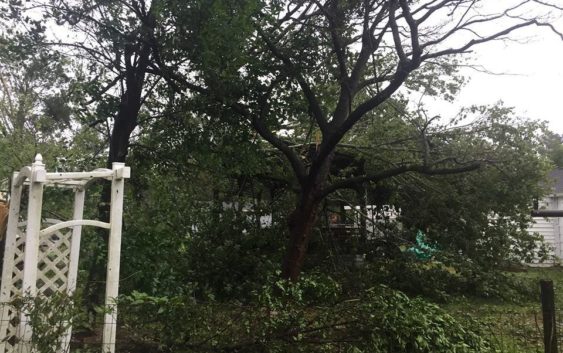- Seven months after Hurricane Helene, Chimney Rock rebuilds with resilience
- Wildfire in New Jersey Pine Barrens expected to grow before it’s contained, officials say
- Storm damage forces recovery efforts in Lancaster, Chester counties
- Evacuation orders lifted as fast-moving New Jersey wildfire burns
- Heartbreak for NC resident as wildfire reduces lifetime home to ashes
HURRICANE FLORENCE: Storms kills 3, downs trees and power lines across region

Wilmington sees strongest wind gust since 1958
SOUTHEASTERN N.C. — Hurricane Florence became a deadly storm Friday, claiming three lives in Hampstead and Wilmington as it roared into, and stalled over, the Wilmington region.
Wilmington police confirmed Friday afternoon that a mother and infant were killed when a tree crashed through their home on Mercer Avenue. And a woman suffered a heart attack Friday and emergency responders were not able to get to her in time, said Tom Collins, Pender County emergency management director.
One man was rescued from the Mercer Avenue home, according to Wilmington Fire Department Chief Buddy Martinette.
More than 125,000 customers were without power Friday as Hurricane Florence arrived in Wilmington with full force, bringing wind, storm surges and historic rain.
Florence’s eye made landfall over the Wrightsville Beach water tower, according to the National Weather Service (NWS) office in Wilmington. It hit the coast as a Category 1 storm with 90 mph maximum sustained winds, the NWS said.
The storm’s arrival brought a 105 mph wind gust at the NWS office about 7 a.m. Friday, said meteorologist Jordan Baker. He said the gust was the strongest recorded in Wilmington since 1958.
Coastal homes and buildings suffered damage from initial wind and storm surges. Through Friday, the storm stalled, dumping historic rains that weather officials said would ultimately be up to 30 to 40 inches in some places. That amount will cause catastrophic flooding throughout the Wilmington region and shatter rainfall records, according to the weather service.
“We call them disasters because they break things,” Brock Long, head of the Federal Emergency Management Agency (FEMA), told reporters while Florence was bearing down on the coastline. “The infrastructure is going to break. … The power is going to go out. It could be out for a number of days.”
On Friday afternoon, the city of Wilmington enacted a curfew from 10 p.m. Friday through 6 a.m. Saturday, Mayor Bill Saffo said.
Numerous roads were closed Friday as the storm raged through and then stalled over Wilmington. Scores of trees and power lines had fallen on roads throughout Wilmington as of Friday afternoon. The Cape Fear River in downtown Wilmington had already swollen by Friday afternoon with storm surges rushing north being met by rainwater pouring into the river.
Body type J: Hurricane Florence has caused some damage to Wilmington International Airport, said Gary Broughton, the airport’s deputy director.
“We’ve got some damage that’s occurring,” he said. “We’ve got some roof issues, parts of roof are coming off and we’ve got some fences coming down.”
“It’s moving very, very slowly,” the weather service’s Baker said of the hurricane.
He said the strongest of Florence’s winds have likely passed, but that the storm’s worst effects had just begun Friday.
“From now own, we’ll have to deal with rain and the possibility of a tornado threat,” Baker said. “After the rain, it’s flooding and river flooding as well.”
The rain began again about 1 p.m. Friday, with forecasters predicting the region will see another 25 inches of rain overnight into Saturday. Wilmington’s previous three-day record total was 19.66 inches recorded in 2010.
Baker said the storm is expected to linger over the region through Saturday morning, but that several dangers will persist even after the rain stops. Baker said the weather service is expecting several rivers to experience record peak flooding — although that won’t happen immediately.
“We won’t be out of danger,” he said. “If you live in an area near a river, the peaks can occur much later.”
Baker warned of continued flooding, washed-out roads and downed power lines for several days after the storm leaves.
“Just because the storm is gone, it doesn’t mean we’re out of the woods yet,” he said. “There are a lot of different hazards. When the storm passes, don’t just go out blindly.”
As of Friday morning, no injuries had been reported in the three-county Southeastern North Carolina region, though numerous other problems have cropped up, including downed power lines, flooded roads and a Brunswick County shelter whose generator failed, leaving people in the dark.
Reporter Tim Buckland can be reached at 910-343-2217 or Tim.Buckland@StarNewsOnline.com.